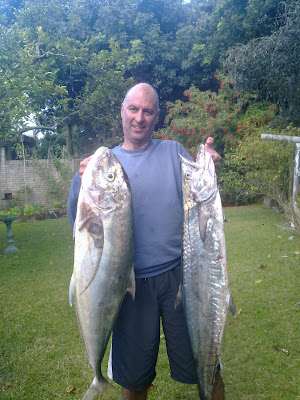Just a quick update. My girlfriend is still not out of St. Augustines Hospital (DBN), that is why I have been diving down in DBN a lot lately. Visiting Hours are only in the afternoon, so why not have a dive in the morning.
I went for a dive at Aliwal Shoal with Neil Myburg and York Lawrance, The Vis was terrible and we scratched around for clean water. We did manage to find some small Couta, everytime we came accross some sugar mackeral. Neil got 2 and York got 1.
Other than that I got some interesting facts about Aliwal Shoal see below. Taken from
http://www.aliwalshoal.com/
Aliwal Shoal
In Brief Aliwal Shoal was first dived in the 1950’s, and was extensively explored in the 1980’s by operators, to ascertain the viability of transporting divers to the launch, in the midst of a world wide scuba diving boom. Umkomaas is the sea side town which provides the launch site for the shoal under the Umkomaas bridge on the river (Mkomanzi) mouth. Lying 3 – 5 kms off shore, Aliwal Shoal is on the inner edge of the Mozambiquan current, and the warm waters often provide for excellent visibility.
A huge array of fish species as well as rays, turtles, sharks and manta’s occupy the shoal, and schools of dolphins and pods of whales are frequent visitors. The shoal is approximately 5kms in length, and runs in a north to south direction. Today, many thousands of divers flock to the shoal in search of excellent diving and true adventure.
HistoryIn 1849, a 3 mast vessel called the ‘Aliwal’ almost collided with the shoal, giving the shoal its now famous name. The ‘Aliwal’ was under the command of Captain James Anderson, and he wrote a report of his experience;
“ From the great interest you appear to take in this place and the coast in general, I think you would like to know that about 30 miles to the southwest from Natal, and distant from the land about two miles, I observed a very large and dangerous rock, or shoal, with heavy breakers.
“I do not find this rock placed upon any chart or alluded to in any directory. I hope therefore, you will speak to the captains of coasting vessels, and inform them of it when opportunity offers.”
Captain James Anderson, In the 'Natal Witness', 14 Jan 1850
Geology
In chronological terms, Aliwal Shoal has a very short history. Eighty thousand years ago, the area around the shoal consisted of a bed of sand dunes. Heavy rainfalls caused sand & shell to dissolve forming a compound of calcium carbonate which was to form the core of the shoal in what became dune rock. The continental plates shifted, which caused a rise in the sea level of the Indian Ocean and hence flooding of the dune.
When the sea levels rose, the dune was submerged, and with more deposits of sand, seashells and other reef-building materials, a massive and elaborate sandstone structure was created. The topography was very rugged with pinnacles, gullies and caves. Coral polyps formed large colonies on the sandstone, and Aliwal Shoal was born. Over time, the shoal has developed into a fascinating site with an abundance of soft corals, sponges, and hiding places. These have combined to attract over 1200 species of fish, as well as turtles, rays, sharks and whales.
Shipwrecks
Unfortunately, two other ships were not so fortunate. The ‘Nebo’ sank on her maiden voyage in 1884, and the ‘Produce’ sank in 1974. These wrecks are both frequently visited on wreck dives.
‘Nebo’This 2000 ton steamship sank on 20th May 1884 just north of the Aliwal Shoal. She was on her maiden voyage from Sunderland to Durban, carrying the Amanzimtoti railway bridge. Although there is no certainty, it was officially reported that she had struck an uncharted pinnacle. There is much doubt about this version of events, especially as the supposed pinnacle has never been reported since.
Some experts believe that the weight of the railway bridge upon the deck could have caused her to be capsized by a large wave. There is more credibility to this story, as the Nebo is lying upside down, 28 metres below sea level.
‘Produce’The Norwegian bulk carrier, weighing in at 15000 tons ripped open her hull on Northern Pinnacles on 11th August 1974. The crew made a brave attempt to get to shore, but the ship was irrevocably doomed and sank shortly afterwards. The crew were rescued, and there were no fatalities.
The rusted framework now provides an established residence for varied fish species, and makes for very good diving. The bridge of the vessel lies 12 metres under the surface, and the ship lies on a sand bed at approximately 35 metres.

